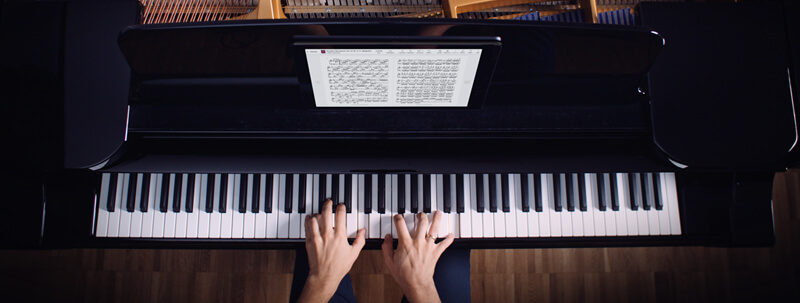The Passacaglia (Handel/Halvorsen) for Piano
Jump to section
You get a fascinating chord poster + exclusive content!
Would you like to learn the Passacaglia?
With the video course for Händel/Halvorsen's Passacaglia, you can learn the simplified version of the piece step by step on the piano. It includes sheet music for printing and professional guidance from a piano educator.
What is a "Passacaglia"?
A Passacaglia was originally a Spanish folk dance. Literally translated, the word meant "walking across the street". However, the first musical examples are not from Spain, but from 17th century Italy. They describe a slow baroque dance.
A Passacaglia is characterized by a repeating bass line ("basso ostinato"), which forms the foundation of the composition. Further ingredients are the main theme - and possibly other themes. These are then varied in the course of the piece. Variations of one or more of the themes interweave over the bass line to form a slow, harmonious piece of music.
Closely related to the passacaglia is the Chaconne, a slightly faster Baroque dance.
The Passacaglia's Historical Origins
This piece of music is based on the last movement of George Frideric Handel's Harpsichord Suite No. 7 in G minor, HWV 432. The Master's Passacaglia already captivates the audience with its baroque splendor. But it became even more popular when new life was breathed into it: The Norwegian composer Johan Halvorsen published a romantic arrangement for viola and violin in 1893. To this day, Halvorsen's version is extremely popular with musicians, music lovers, and concert-goers.
How to Learn the Passacaglia by Handel/Halvorsen on the Piano
The Passacaglia is ideal for you if you have some experience on the piano. 1-2 years of piano learning is perfect.
- Start by reading the sheet music. At OKTAV, we have arrangements for several difficulty levels, from level 18 to level 46.
- Familiarize yourself with the structure of the piece. At OKTAV, we have a "parts" button that, once activated, will automatically show you the different parts: Intro with the ostinato bass, 3 variations, coda (end).
- Learn the left hand. Take your time with it because the notes in the bass clef are the foundation of the piece. In our Passacaglia - Song Tutorial, OKTAV piano teacher Carmen Manera will show you how to practice all the jumps.
- Practice all three variations in the right hand and be careful not to overexert the hand. The right technique will help with that.
- Bring it together. Practice each variation with both hands. Take your time!
- Practice the whole piece focusing on finger coordination and rhythm.
- The Passacaglia contains a whole range of dynamic markings. Pay attention to dynamic instructions.
- Speed up if necessary. Watch your tempo and your phrasing. Bring everything to life.
Other Famous Passacaglias
Handel's Passacaglia is just one among quite a few famous Passacaglias:
- Johann Sebastian Bach - Passacaglia and Fugue in c-Minor, BWV 582: Bach's work is an exemplary Passacaglia - complex melodies seem to hover over a serene ostinato bass.
- Dmitri Schostakowitsch - Passacaglia from Symphony No. 8: This symphonic Passacaglia is a mighty, emotional piece of work. The ostinato bass repeats over 11 times while tension and drama increase.
- Benjamin Britten - Passacaglia from "Peter Grimes": Britten's opera "Peter Grimes" contains a Passacaglia. Its bassline recurs 38 times underneath a fascinating viola theme. The music emphasizes the main character's emotional turmoil.


